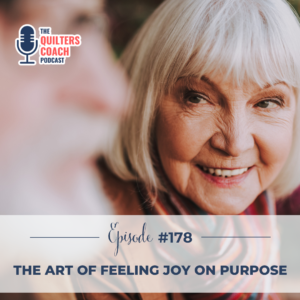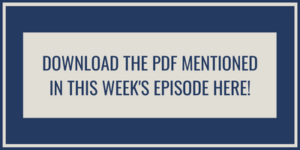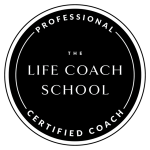
Do you find yourself struggling to feel joy, even when you look around and see everything you have? If you’ve ever wondered why it’s so hard to feel joyful in the everyday moments of life, this episode is for you. Join me as we explore what joy really means, why it sometimes feels elusive, and how to embrace it more intentionally.
In this episode, I share heartwarming wins from my clients and practical tools to help you discover and cultivate more joy in your life. We’ll redefine joy, uncover how your brain influences what you notice, and explore ways to record and measure joy to create a more balanced and fulfilling life. Whether it’s through reframing your thoughts, anchoring your experiences, or measuring progress, these strategies will help you live more intentionally and with purpose.
If you are ready to lose weight and change the way you think about hunger, sign up for the lifetime access of The Pieceful Heart Membership! Doors are open and you can find all the information by clicking here.
What You’ll Learn from this Episode:
- How to define joy in a way that resonates with you and fits your life
- Tools to intentionally seek, record, and amplify moments of joy
- Strategies for embracing both positive and negative emotions to create a balanced and fulfilling life
Please continue to rate this podcast, and follow me on Instagram for more tips and support.
- Watch this episode on YouTube.
- If you are ready to lose weight and change the way you think, sign up for the lifetime access for The Pieceful Heart Membership! Doors are open and you can find all the information by clicking here.
- Leave me a review in Apple
Full Episode Transcript:
178. The Art of Feeling Joy on Purpose
Do you find yourself struggling with feeling joy? Especially when you look around yourself and see everything that you have. Well, this episode is for you. My name is Dara Tomasson, and this is episode 1 78. The quilters coach podcast.
And we’re talking about feeling joy. I like to start off the podcast with wins of the ladies in the membership and how the ripple effect affects their family because they’re doing the work.
I have a client who thought that it wouldn’t be a good idea to do an album of all of the things we did this year or a themed album. And so she was going through pictures. Of this past year and. She was just amazed. And how differently she looks at herself now. So in the past, when she would take a look at a picture of herself, she would get really mad and feel frumpy. She was very critical of herself. as she was looking over the pictures and experiences, she was able to see how blessed she really is.
She was much less critical. And judging, she was able to feel so much joy. I absolutely love that. In fact, that’s one of the reasons I want to share this podcast working with her and seeing this transformation. It’s not just for her, it’s for all of us.
I wanted to share some tools and ways that we can do that. Listen up and if you’re watching hello, if you’re listening. Hello. if you’re watching, you can see the worksheet that I’m going to be working from. If you’re listening, you can just download the worksheet. I have a worksheet for every podcast, because I know for my brain, it really helps me to be structured that way. I want you to ask yourself. How often do you feel joy? recently my husband was talking about joy. the way that he defines joy is very different than how I define joy. For him, joy is something that you don’t feel very often.
It does a really big buildup to it. It takes a while to feel it. And it’s kind of a precious thing. Whereas for me, I feel joy all the time. I feel joy watching my kids Excel at something. I have joy watching my kids. Worked through something that’s hard and then they they don’t quit.
I see joy in so many little things. And that’s just because I have a different way of thinking about joy. So I would like to offer for all of you. to decide, how would you even define joy? What is it? As you think about it. I want you to ask yourself how often do I allow myself to feel joy? This is really good. Question because what it’s doing is it’s directing your brain. To look at things in an ant. But being really clear.
So even on the call with my client, we had to look it up. definitions of words. when she could. Say, ” What do I feel? And how is that? So just a simple definition of joy. the noun is a feeling of great pleasure and happiness, so we can have tears of joy. Or a verb would be to rejoice.
Like I felt shame that I had. Ever enjoyed this discomfort or pain. So we have lots of different people who have different definitions of Joyce, for example, a feeling of great pleasure or happiness that comes from success. Good fortune. Or a sense of wellbeing, gladness. What about. A source of a cause of keen pleasure or delight. If you want to go to the deep meaning of joy, joy is a deeper emotion than happiness. Then happiness that comes from within, from a sense of purpose and meaning, including finding meaning and suffering. And from relationships with others. It therefore lasts longer than its counterpart.
It’s also relatively independent from happiness. According to certain people. As you can see, a very simple search can feel a little bit confusing. So even from a psychologist, they define joy as a pleasant state that shares conceptual space with other positive emotions, such as gladness.
But then when you start driving, what are you going to notice? Of course, the yellow cars. What was it? It was secular. I didn’t know that word before, and then it seemed like everywhere I turned, I kept hearing the word secular. I didn’t even know what this word meant before and now I’m hearing it everywhere. It’s because now your brain has awareness of it. Just like with my client when she used to feel really bad about herself she would look at a picture and say, oh, look at that belly or, oh, look at those cheeks that was just her brain looking for all the flaws. And imperfections instead of the other way around.
I’m curious for you, how often do you allow your brain? To only focus on one thing and find evidence for that one thing. Because if that’s the case, then you’re probably feeling a lot of discouragement, and a lot of unhappiness. That’s a really important tool just to be aware of. Now the second tool that I want to offer to you to help you to feel more joy. Is to record it.
So making a record of the times when you feel joy, if we are always going on autopilot, we are going into that habit brain, right. The problem with default thinking is that it’s running its course, and we don’t have a lot of impact or influence on what that course looks like.
Living intentionally and on purpose, deciding what I want? What feels good for me? And I call this my anchor journal and it’s a time when I know that God is in my life. when you think about a boat in a storm if you throw down the anchor, despite All the crazy. It will stay where it needs to be.
For me, my anchor journal helps me to really focus on what things are the most important. And also knowing I’m on the right track. Keeping this record and physically writing this down is really helpful because it allows us. To see where we’re at and give us direction. The third tool that I want to offer to help you feel more joy. Is to always measure backwards. So there’s the book written by a bench Dr.
So the acronym is eat, which I love. And so when I will find myself or Y with my clients and we’ll do a thought download. And so I’ve thought downloading is literally writing down everything that’s in your brain. On a piece of paper and then I’ll ask them to write it down. What are the emotions for each one of those thoughts?
They’ll write down their emotions and now I have them back. So let’s say they did 10 thoughts. Then they have, you know, 10 different emotions. I said, now you classify what is a positive emotion and what is a negative emotion? And if they have seven negative to three positive, that’s not having an equal airtime in your own brain. I will ask them to find seven. Positive thoughts. About that situation. And that’s super, super helpful for them. So I am just going to offer that you can do these four simple things. Tools. To help you to feel joy. Now. In order to have a healthy, balanced life you are that there’s always going to be the negative and positive.
Always. There’ll always be 50% positive, 50% negative. That’s just the way things go. So I want you to decide right now on purpose to realize yep. You know what, to have a healthy balanced life, I will have negative and I will have positive 50% of the time. But when aware of that, then that is negative. Doesn’t. Isn’t such a big deal.
It’s just part of life. When I am doing these renovations or when I’m, you know, had a goal and didn’t quite hit it. I will, instead of beating myself up and just drowning and you know, what. Waiting for the negative, I can just allow the negative and say, oh, this is my day.
That feels really negative. Okay. I’m just going to allow it to be there. I’m not going to make a big deal of it. And I’m going to move forward. So I’m really curious to hear your feedback on this one. I think that joy. Is one of ’em. It’s way more available to us than we thought. When I was a school teacher, I had twin boys in my class. And their uncle was a jeweler. And they made me a ring one year. And I had them for three years. And the ring said joy. And they said, Ms.
Bobby, you are a joy. You bring us so much joy. And I, I have always thought that was just so sweet that they, they thought of me and they associated joy. And I hope that for all of you, direct your brain. You can live a life of intention. And decide I’m going to live a life where I’m going to allow joy because you know, it’s very hard to not feel joy.
It’s very easy to focus on the negative and to see all the negative. And so to make that a practice where I live a life of joy on purpose. Such a great decision. All right. Thank you so much for joining me. I can’t wait to hear back from you on what your takeaways are from these training sessions. I always love to hear from you. It’s just such a pleasure. To know I’m recording this and it’s going to go all over the world and help so many people. And, one of the things I ask you is to share it with your friends or at least. Write a review.
If you love this podcast, please write a review because it will gain more traction. Two more people we can help more people feel more joy. All Take care, everyone. Bye




